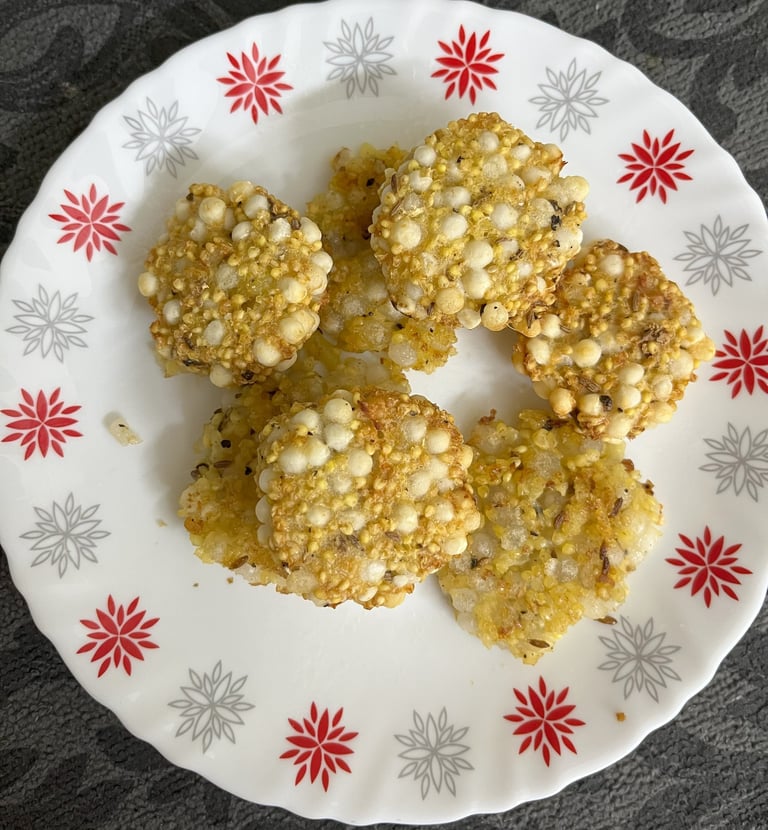Deliciously Nutritious: Proso Millet Sabudana Vada Recipe
Sabudana Vada, a beloved Marathi snack with high GI gets a healthier addition with proso millet grains!
FOOD
Twinkle Suri
11/23/20254 min read


Proso millet, scientifically known as Panicum miliaceum, is a small, gluten-free grain that has been cultivated for thousands of years, particularly in Asia and East Europe. This ancient grain is celebrated not only for its versatility in culinary applications but also for its rich nutritional profile. Proso millet is an excellent source of essential nutrients, including magnesium, phosphorus, and potassium, making it a favorable choice for health-conscious individuals and those adhering to gluten-free diets. This grain is rich in protein, and fiber. Proso millet is known for its ability to help stabilize blood sugar levels, making it an excellent choice for individuals with diabetes. Additionally, it aids digestion and promotes heart health due to its beneficial effects on cholesterol levels. In various cuisines, proso millet has found its way into numerous preparations, ranging from porridge to baked goods and savory dishes. Its mild, nutty flavor complements other ingredients well and absorbs spices beautifully.
Sabudana, commonly known as tapioca pearls, originates from the cassava root, primarily found in South America and Africa. Traditionally utilized in Indian cuisine, sabudana is popular during fasting periods as it provides instant energy. Sabudana is utilized in a variety of traditional recipes, adding a unique texture and slight chewiness to dishes such as vadas and khichdi. These translucent pearls are rich in carbohydrates, low in protein, and are gluten-free as well, making them a suitable option for those with dietary restrictions. But being high in carbohydrates, and traditionally added with ingredients like boiled potatoes, this dish is inherently high in natural sugars and have an overall high glycemic index (GI). Addition of proso millet not only diversifies the grain intake, but also enhances the culinary experience and provides numerous health benefits, contributing to a balanced diet rich in vitamins and minerals. Also, while sabudana pearls lack significant amounts of vitamins and minerals, when combined with proso millet the dish generates a more balanced nutritional profile.
Ingredients (for 9 to 10 pieces):
Proso millet grains - 1/4 cup
Sabudana (Tapioca) pearls - 1/4 cup
Potato (boiled) - 1 medium
Groundnuts (roasted) - 2 to 3 tbsp
Salt - as per taste
Fresh green chilies (chopped) - 2 nos. (or as per taste)
Ginger (grated) - 1/2 inch
Cumin seeds - 1 tsp
Sugar (optional) - 1/2 tsp
Coriander leaves (chopped) - a handful
Water - 1/2 cup
Oil - for frying (optional)
Step-by-Step Preparation:
Start by measuring the proso millet and sabudana perals. Rinse both ingredients thoroughly under running water to remove any impurities. Once cleaned, soak them separately in water, sabudana pearls for about 4–6 hours or overnight, and proso millet grains for approximately 2–3 hours. This soaking process is crucial for ensuring a fluffy texture in the vadas. After soaking, drain the sabudana and proso millet separately.
Now, take the water in a pan. when it starts to heat, add the proso millet grains and cook them on low to medium heat till they are about 80% cooked. Cooking the millet grains is similar to cooking the rice.
Now, in a bowl mash the boiled potatoes with your hand or a spatula and combine the soaked sabudana and the proso millet grains with it. It is essential to ensure even distribution for a uniform texture.
Add the rest of the ingredients - roasted groundnuts, sugar, cumin seeds, finely chopped green chilies, ginger, and fresh coriander leaves for flavor enhancement, and sprinkle in salt to taste.
To bind the mixture together, incorporate a small amount of water if necessary, but be cautious not to make it too wet. The ideal consistency should allow you to form patties without the mixture crumbling. Now, shape the mixture into small, round vadas, about the size of a golf ball, and lightly flatten them.
In a deep pan, heat oil for frying over medium heat. Once the oil is hot, carefully slide the shaped vadas into the oil, ensuring not to overcrowd the pan.
Fry them until they turn golden brown and crisp on both sides, which typically takes around 3–4 minutes per side. It's advisable to keep the heat steady to avoid burning. A common mistake is turning the vadas too soon; allow them to form a crust before flipping.
Once done, transfer the vadas to a plate lined with paper towels to absorb excess oil. Enjoy the crispy, nutritious vadas as a delightful snack or appetizer.
Proso millet sabudana vada is not only a delicious dish but also quite versatile. It can be served in numerous ways, catering to various taste preferences. A popular serving suggestion is to accompany these vadas with a variety of dips and chutneys. Green chutney, made from fresh coriander and mint, provides a zesty flavor that complements the crispy texture of the vada perfectly. Alternatively, a tangy tamarind chutney can add a sweet and sour contrast, enhancing the overall dining experience. For those seeking a more refreshing accompaniment, yogurt raita mixed with diced cucumber or pomegranate seeds can add a creamy element to the dish. This combination not only balances the spices but also offers a cooling sensation that can be particularly pleasing during warmer months.
Variation suggestions:
One can experiment by incorporating different herbs and spices such as ground coriander seeds, ground cumin etc.
For additional nutrition, shredded spinach, grated carrots, or other seasonal vegetables can be included, tailoring the dish to meet specific dietary needs with addition of Vitamin A and C, potassium and fiber content.
You can also incorporate cottage cheese (paneer), tofu or boiled lentils/ legumes to add the extra protein into this dish.
Substitute potato with sweet potato.
Moreover, those who prefer a spicier version may choose to mix in a pinch of garam masala or red chili powder, depending on their heat preference.
Finally, bake or air fry them if you want them to be oil-free or prepared with a minimal use of oil.
If you do not want the texture of proso millet grains in your mouth, skip step 2 and instead air-dry the grains to then blend them into a coarse flour using a food processor. This flour will serve as the base for your mixture; use it instead of the grains and follow the further recipe as such.
These creative interpretations not only make the sabudana vada more appealing but also assist in incorporating a broader range of nutrients into one’s diet. Also, this dish is a perfect appetizer or snack for gatherings and special occasions.
I'd suggest to explore the full potential of proso millet sabudana vada now, showcasing its adaptability for any meal, diet or occasion!


